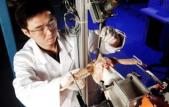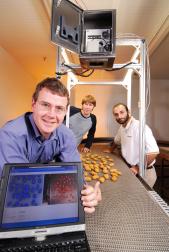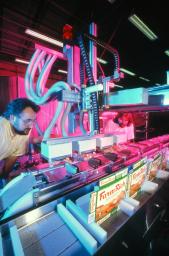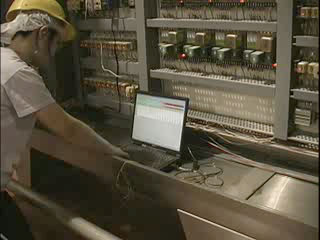Georgia's nation-leading poultry industry has been the catalyst and chief beneficiary of the application of technology to the agriculture business. These efforts include the establishment of Agricultural Technology Research Program in 1973.
Reducing Sound Levels in the Plant
It started with a bang, or more accurately, noise. Concerned with mitigating the high levels of equipment noise in poultry processing plants, the Georgia Poultry Federation turned to Georgia Tech for help.
GTRI researchers conducted one of the first definitive studies of the noise environment in a poultry plant. Teaming with NASA, researchers developed sound-absorbing fiberglass panels with a special high-tech film coating. The coating was capable of withstanding frequent washdowns while also letting the noise penetrate to the soft, absorptive center. When installed on the ceiling of a plant, the panels reduced sound levels by two orders of magnitude. They were later marketed under the name Sanitary AcousTech Sound Panels.
Through the remainder of the energy-conscious 1970s, the Poultry Federation frequently returned to Georgia Tech with concerns that resulted in several demonstration projects. Much of the research focused on energy efficiency and alternative fuel resources, including wood, solar energy, and methane.
Efficient Recovery of Skimmings
In the 1980s, interest shifted to systems development projects dealing primarily with environmental compliance, electronic automation, and plant maintenance practices. Agricultural Technology Research Program activities included the development of a faster and less expensive way to remove water from a valuable poultry byproduct called skimmings. Speeding up the separation process without adding chemicals was a major enhancement in the efficient recovery of skimmings.
Automating Poultry Inspections
In another project, data entry terminals were networked along a processing line, forming the basis for a tracking system to automate post-mortem poultry inspection. Created by Georgia Tech scientists, the innovative information management project enabled plant personnel, under a U.S. Department of Agriculture initiative, to assist with the inspection procedure. It evolved from a similar Georgia Tech-created system for monitoring poultry quality.
A Focus on Applied Technology
Building on the foundation set by its previous work, Agricultural Technology Research Program research has had a major focus on applied technology. Projects were divided into five areas:
- Environmental sustainability
- Ergonomics and worker safety
- Food safety
- Factory automation
- Computer information systems
"We're pushing the technology frontier and starting to deliver breakthroughs in low-cost imaging, robotics, and sensor technologies," said Craig Wyvill, chief of GTRI's Food Processing Technology Division. "We're also involved with some really innovative digital signal processing work, and coming up with software that can discriminate scenes and images to make determinations on good and bad quality features, which is not easy."
Water consumption tops the list of environmental issues of concern to the poultry industry. Researchers are studying water-saving approaches to the rinse cycle in poultry and meat processing, as well as ways to get "the most bang for the buck" with new technologies for wastewater treatment, Wyvill added.
Poultry and Beyond
Other major GTRI projects include:
- Machine vision and sophisticated image analysis to provide the basic technologies behind a systemic screening system.
- Optimal real-time control over the poultry-processing line.
- A sensor-based intelligent-cutting system.
- A durable robot that packs fresh meat into trays.
Poultry processing offers a tremendous and relatively untapped opportunity for the application of technology. GTRI is making these technologies more cost-effective and, therefore, available for other industry sectors.





